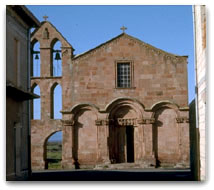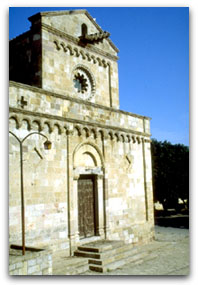Another church of rare and wondrous
beauty is the church in Bulzi, in the province of Sassari. It is dedicated to San Pietro, and is
sometimes called "the church of the images" because, on its architrave, an unknown stone
mason engraved some strange mysterious looking pictures. Despite the sobriety of its style
this church is admired for its special elegance which results from the fact that it was built
using alternate rows of black basalt and white limestone. Among the churches of this period
there is also the cathedral in the province of Oristano, dedicated to Santa Giusta, a girl who
was martyred during Adriano's Empire. This cathedral, besides its other features has a series
of columns and capitals of high artistic quality, which were taken from the ruins of the nearby
Phoenician city of Tharros, or according to what Fara asserts in his "chorografia", they were
taken from a mysterious city called Hiadis, which was submerged by a nearby salt water
pond, although this explanation is probably
unfounded.
|
|

 The Cathedral of S. Giusta The Cathedral of S. Giusta |

 S. Pietro in Zuri S. Pietro in Zuri |
|
It is true that there is another
Mediaeval church in Sardinia which ran the risk of being submerged. It is the cathedral in Zuri,
in the province of Oristano. Zuri was a village where, in 1291, a beautiful red trakytic church
was built. Valore Deligia was murdered in this church in 1416. He was a nobleman who was
accused of betrayal. For this reason an ambush was laid when he was with his son Bernardo.
In an attempt to escape from the killers the two men took shelter in this cathedral and tried to
protect themselves by hiding behind the statue of San Pietro. However they were found and
killed. Traces of blood, probably belonging to the two unlucky men, can be still seen on this
statue.
|
At that time the church was
surrounded by an unbelievably beautiful petrified forest. However in 1923, the valley where
the basilica was, was submerged to create an artificial basin. Before the valley was flooded
the temple was taken down, stone by stone, and was rebuilt faithfully, and can now be visited.
The keys are available from the owner of the nearby house. This church is important for
another reason. On one of its capitals are engraved some pictures of dancers doing a
whirling "ballu tundu", a typical centuries old Sardinians dance, which is still performed
today. This dance probably had a propitiatory origin and it was probably done around a fire.
In Tratalias, in the province of Cagliari, there is another Romanesque church which should be
visited. It was built in 1213 because the cathedral of the diocese, which was in the coastal
village of Sant'Antioco, had become unsafe because of frequent raids by pirates. This church
has beautiful white trackytic architecture.
|
|

 S. Maria in Tratalias S. Maria in Tratalias |
|